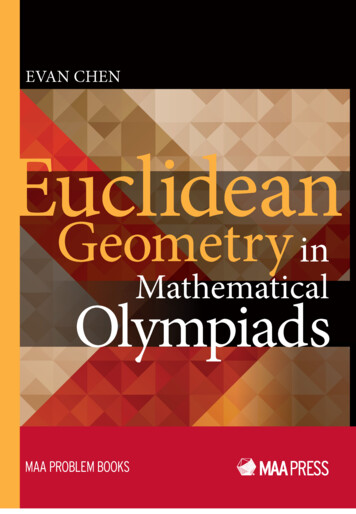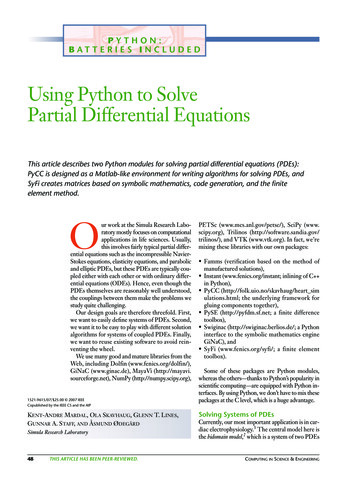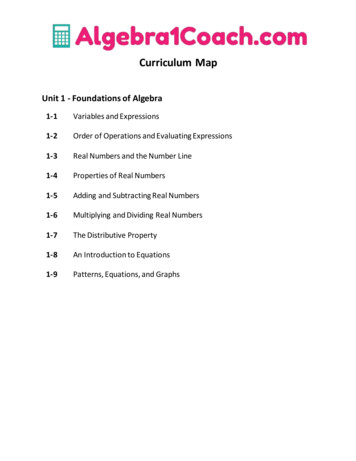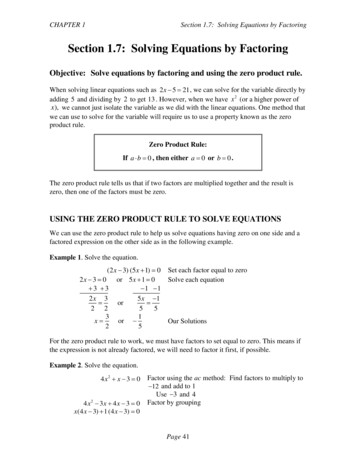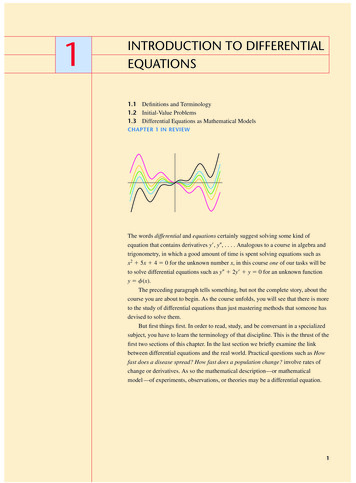
Transcription
Functional EquationsinMathematical OlympiadsProblems and SolutionsVol. I (2017 - 2018)ByAmir Hossein ParvardiThe University of British ColumbiaMathematics DepartmentVancouver, CanadaMay 2018
Dedicated to my lovely wife, Nadia.
Preface
6PREFACEForeword by pcoTo me, solving functional equations has always seemed similar to carryingout police investigations. Starting at the scene of the crime, we can immediately establish a certain number of properties (the values for certainconfigurations of variables, existence of cases in which simple properties canbe used right away, etc.).After collecting the initial clues and seeing how they fit together, wecarry out a second search for properties, without necessarily immediatelyadvancing toward a solution. We are content with widening the field ofcharacteristics and information that we possess about the culprit.Now comes the moment where the clues combine to grasp our attention(a profile of the criminal and similarities with known crimes start to emerge,etc.), and our field of suspects narrows. At this point, we only focus on theclues that seem to lead towards the emerging criminal profile. This continues right up until the discovery of the culprit.In the world of functional equations, I add an additional step (and officially leave the world of police investigations): I look at the trail of cluesthat led me to the solution, and I simplify it, search for shorter paths, andessentially, optimize it. This step is intellectually satisfying as it producessolutions that seem magical, but it is not very satisfactory for a book likethis one. It makes more sense, educationally speaking, to reveal the entireprocess, including the sterile reasoning branches (something many peopleask me about when questioning my motivations).My only regret in letting Amir Hossein use certain solutions of mine inthis superb work of compilation, sorting and ranking, is that some of thesesolutions (whether they come from me or other contributors) remain a bitmagical and not very educational. In this regard, it seems to me that thecollection of reflections elaborated upon by the author throughout the firsttwo chapters of this book must be read attentively. Often, these reflectionsmotivate solutions proposed in subsequent chapters.pco,1May 29, 2018.1Note from the author: thanks to Jenna Downey for translating pco’s words fromFrench to English.
7About This VolumeFunctional equations, which are a branch of algebraic problems used inmathematical competitions, appear in recent olympiads very frequently. Theknowledge needed to solve olympiad-level functional equations is basicallynothing more than a 20 page handout. Therefore, there are very few bookson the subject in olympiad literature.My initial goal for creating a problem set in functional equations wasto publish a book of over 3000 questions solved by the user pco in the forum of High School Olympiads at AoPS Community. These questions wereposted in the period [2003, 2018]. After starting the project, I soon realized3000 is not a small number at all, and it is impossible to gather all thoseproblems together (which would probably make a 3000 page book). Furthermore, nobody is willing to see three thousand functional equations. So,I decided to publish the best problems among these – as some were CrazyInvented Problems – which would be around 1500 questions. Also, I decidedto publish these problems in a few lighter volumes instead of one thick book.This volume contains 175 problems on functional equations, includingthose used in almost all latest mathematical olympiads (2017 – 2018 ) aroundthe world. As mentioned above, most solutions were written by pco, butthere were several other users who were kind enough to let me borrow theirsolutions and have it in the collection. Please follow the instructions forreading the book in order to get the best out of it.Amir Hossein Parvardi,May 28, 2018.
Acknowledgments I would never be able to finish this book without the never-endingsupport from my wife, Nadia Ghobadipasha. Most of the credit and respect goes to pco, as he was the man whomotivated me with his hard work in solving algebra problems to createthis problem set. Most of the solutions in this book are due to pco. The following is a list of people who gave me permission to include theirsolution in this book. The list is in alphabetical order. To respect theirprivacy, I’m just using the AoPS username of the author in case theydid not want to reveal their name:– Catalin Dumitru(Buzau, Romania)– Nikola Velov– Evan Chen– scrabbler94– Kevin Ren– Stefan Tudose– Loppukilpailija– Sutanay Bhattacharya– Minjae Kwon (Seoul, Korea)– talkon– Murad Aghazade– ThE-dArK-lOrD– Navneel Singhal– Tuzson Zoltán– Roman Buzuk (Belarus) I am thankful to Pang-Cheng Wu and Ting-Wei Chao for giving meaccess to their notes on functional equations. I have used some partsof their solution for solving the general Cauchy’s equation. Mohsen Katebi wrote Python codes which were used to generate aninitial draft for the problems. His work saved me a lot of time. The cover of the book was designed by Ali Amiri. The photo in thebackground of the cover is the complex-valued graph of Riemann’szeta function and was taken from Meta.Numerics website. The foreword was initially written in French by pco. I am thankful toJenna Downey for translating it to fluent English. Finally, thanks to Kave Eskandari, Reza Miraskarshahi, Abtin Eidivandi, Alireza Jamaloo, Koosha Irani, Kasra Hendi, Sohrab Mohtat,and Mohsen Navazani for their comments on the structure of the book.
CONTENTS9ContentsPrefaceForeword by pco . . . . . . . . . . . . . . . . . . . . . . . . . . . .About This Volume . . . . . . . . . . . . . . . . . . . . . . . . . .Acknowledgments . . . . . . . . . . . . . . . . . . . . . . . . . . . .1 Instruction for the Reader1.1 How to Use This Book . . . . . . . . . . . . .1.1.1 The Preamble . . . . . . . . . . . . . .1.1.2 Problem Solving . . . . . . . . . . . .1.1.3 Solutions and Hints . . . . . . . . . .1.2 General Knowledge on Functional Equations1.3 Solving More Problems . . . . . . . . . . . . .2 Basic Concepts2.1 Notation and Definition . . . . . . . . . . . . . . . . .2.2 Concepts . . . . . . . . . . . . . . . . . . . . . . . . .2.2.1 Injection, Surjection, and Bijection . . . . . . .2.2.2 Monotone Functions . . . . . . . . . . . . . . .2.2.3 Even and Odd Functions . . . . . . . . . . . .2.2.4 Involutive Functions . . . . . . . . . . . . . . .2.2.5 Functions Related to Integers . . . . . . . . . .2.2.6 The Bad Gui, Complex Numbers, and Roots of2.3 Classical Functional Equations . . . . . . . . . . . . .2.3.1 Cauchy’s Functional Equation . . . . . . . . . .2.3.2 Jensen’s Functional Equation . . . . . . . . . .2.3.3 General Solutions . . . . . . . . . . . . . . . . .2.3.4 Deviation from the Classical Equations . . . .3678.13131313141516. . . . . . . . . . . . . . . . . . . . . .Unity. . . . . . . . . . . . . . . .1920222224262728303131333436.
10CONTENTS3 Problems3.1 Functions Over C . . . . . . . . . . . . . . . . . . . .3.2 Functions Over R . . . . . . . . . . . . . . . . . . . .3.2.1 Cauchy-type and Jensen-type . . . . . . . . .3.2.2 Continuity . . . . . . . . . . . . . . . . . . .3.2.3 Injective, Surjective, and Monotone Functions3.2.4 Existence . . . . . . . . . . . . . . . . . . . .3.2.5 Trigonometric and Periodic Functions . . . .3.2.6 Functions Combined with Polynomials . . . .3.2.7 Functions on R . . . . . . . . . . . . . . . .3.2.8 Sequences . . . . . . . . . . . . . . . . . . . .3.2.9 Inequalities . . . . . . . . . . . . . . . . . . .3.2.10 Miscellaneous . . . . . . . . . . . . . . . . . .3.3 Functions Over Q . . . . . . . . . . . . . . . . . . . .3.3.1 Cauchy-type and Jensen-type . . . . . . . . .3.3.2 Injective, Surjective, and Monotone Functions3.3.3 Functions on Q . . . . . . . . . . . . . . . .3.3.4 Miscellaneous . . . . . . . . . . . . . . . . . .3.4 Functions Over Z . . . . . . . . . . . . . . . . . . . .3.4.1 Number Theoretic Functions . . . . . . . . .3.4.2 Functions on N . . . . . . . . . . . . . . . . .3.4.3 Trigonometric and Periodic Functions . . . .3.4.4 Inequalities . . . . . . . . . . . . . . . . . . .3.4.5 Miscellaneous . . . . . . . . . . . . . . . . . .3738393939414444454649505161616161626363666767694 Selected Solutions4.1 Functions Over C . . . . . . . . . . . . . . . . . . . .4.2 Functions Over R . . . . . . . . . . . . . . . . . . . .4.2.1 Cauchy-type and Jensen-type . . . . . . . . .4.2.2 Continuity . . . . . . . . . . . . . . . . . . .4.2.3 Injective, Surjective, and Monotone Functions4.2.4 Existence . . . . . . . . . . . . . . . . . . . .4.2.5 Trigonometric and Periodic Functions . . . .4.2.6 Functions Combined with Polynomials . . . .4.2.7 Functions on R . . . . . . . . . . . . . . . .4.2.8 Sequences . . . . . . . . . . . . . . . . . . . .4.2.9 Inequalities . . . . . . . . . . . . . . . . . . .4.2.10 Miscellaneous . . . . . . . . . . . . . . . . . .4.3 Functions Over Q . . . . . . . . . . . . . . . . . . . .4.3.1 Cauchy-type and Jensen-type . . . . . . . . .71727373747786889193100103107138138
CONTENTS4.44.3.2 Injective, Surjective, and Monotone Functions4.3.3 Functions on Q . . . . . . . . . . . . . . . .4.3.4 Miscellaneous . . . . . . . . . . . . . . . . . .Functions Over Z . . . . . . . . . . . . . . . . . . . .4.4.1 Number Theoretic Functions . . . . . . . . .4.4.2 Functions on N . . . . . . . . . . . . . . . . .4.4.3 Trigonometric and Periodic Functions . . . .4.4.4 Inequalities . . . . . . . . . . . . . . . . . . .4.4.5 Miscellaneous . . . . . . . . . . . . . . . . . .11.139140140142142146149150152AppendicesA Hints and Final Answers159B Contributors169
Chapter 1Instruction for the Reader1.11.1.1How to Use This BookThe PreambleThis is a bank of questions on functional equations. So, you might wantto skip the first parts and move to problem solving right away. But pleasedon’t. Take your precious time to read the next pages before trying theproblems in the book. I can guarantee that no matter what your level is onthe subject, you will find the content interesting.1. Skim through definitions so we are on the same page. There are a fewphrases which are frequently used throughout the text.2. Do not let easy-looking titles in section 2.2 deceive you into thinkingthat the problems in that section are straight-forward and easy. Besidevery basic definitions of concepts in functional equations, I give severalexamples in which those concepts are used, and a good number of theexamples are not trivial at all. So, please do not skip reading thissection.3. In fact, section 2.2 gives you a gist of the solutions in chapter 4.4. There are possibly concepts and definitions which need to be added tothis preamble. If you feel that I should include an introduction to anyspecific topic, please let me know and I will add it in the next editionsof this volume.1.1.2Problem SolvingAfter you read the preamble, you have 175 incredible problems ahead of youto solve! Some tips on how to solve them:1. The problems have been separated based on the domain of the functions in the problem. Then each domain has its own special subcategories. Although problems on R are more popular in mathematical competitions, it is possible that you get a very hard problem over
141.1. HOW TO USE THIS BOOKQ or N in your olymiad exam paper. That being said, if it is the firsttime that you are solving problems from this book, I encourage youto solve one or two problem from each domain (rather than solving Rcompletely first, and then Q and Z). This way, you won’t be focusingon one type of problem only.2. Try changing the sub-categories of the problems that you solve periodically as well. For instance, solve two questions on existence-typeproblems over R (section 3.2.4) and then one on number theoreticfunctions (section 3.4.1), and so on.3. Do not try CIP problems at home. CIP is an abbreviation used bypco. It is short for Crazy Invented Problem. Such problems were eitherrandomly generated by curious students or are too hard for no goodreason. There shouldn’t be more than 10 such problems in this book,but I labeled them as CIP because they can waste your time if youare studying for an olympiad. These problems are difficult! So, even ifyou want to try them, do it at your own risk because they could eacheasily get two hours of your time and don’t lead to anywhere.1.1.3Solutions and Hints1. The solutions in this book were mostly written by user pco on AoPS.I have edited his solutions to fit in this book, but there are possiblyerrors in them. If you find any mistakes in the book, please send themto my email at a.parvardi@gmail.com.2. Not all the problems have solutions or hints. There are a few onesthat have neither a hint nor a solution, but I have tried to give at leasta hint when the solution is not presented. If you want me to includeyour solution (and give you the credit) in this book, please shoot mean email.3. In my opinion, the best way to solve problems from this book is tothink on the problem for half an hour, and if you have struggles, checkthe hints. If there are multiple hints, do not read all of them at once.Read the first hint, try it, and if you still don’t get the idea, readthe next hint. The same is true for the solutions. Try to prove theclaims made in the solutions before reading the given proof. This willimprove your problem solving abilities.
CHAPTER 1. INSTRUCTION FOR THE READER154. Some of the proofs by pco (and other authors) are just incrediblyamazing. Even if you solve the problem successfully, do not miss thesolution if it is given in the book.5. Enjoy!1.2General Knowledge on Functional EquationsThis book starts with a chapter on basics of functional equations. I havetried to include almost all the necessary definitions needed to solve problems in the book. My approach is example-based so you can make a goodconnection to the problems and have a sense of what you are going to seethroughout the book: you might know by a handful the whole sack.For those of you who are enthusiast in reading more on the subject andlearn advanced techniques in problem solving, I’m listing a few good sourcesthat I know of: I never had the chance to read Venkatachala’s book [1] as it is onlyavailable in Amazon India, but I have read very good reviews about itand it is considered as one of the best books on the elementary theoryof functional equations. Chapter 2 of Small’s book [2] contains detailed solutions to famousclassical functional equations such as that of Cauchy, Jensen, andD’Alembert. Knowing a detailed proof for Cauchy’s additive equation is a must for olympiad students, and hence this chapter is prettymuch appreciated. Pang-Cheng Wu’s recent notes on functional equations are perfect. Istrongly suggest you read his impressive functional equations handouton AoPS if you want to learn cool techniques and see a bunch ofamazing problems. I have used some parts of his work in section 2.3of this book. Evan Chen’s handout on functional equations is a top-notch work.Make sure that you read his notes. He also has a handout called Monsters on his website which is dedicated to difficult problems (“pathological functional equations”).
161.3. SOLVING MORE PROBLEMS1.3Solving More ProblemsIf you cannot wait until I publish the next volumes of this book, keep yourselfbusy with solving problems from the following question banks: 116 Problems in Algebra by Mohammad Jafari has quiet good problems, especially in functional equations. Almost all the problems havebeen solved by AoPS members, and it is a good exercise for the readerto try those problems. Some of the problems are pretty tough (a fewwere used for Iran IMO team selection tests) and might be a goodexercise if you are in for heavy-lifting. 100 Functional Equations by yours truly is a collection of problemsposted on AoPS fora around 2009 to 2011. Functional Equations Marathon on AoPS used to be very active ingood old days. Give its problems a try if you don’t mind solving a fewCIPs.
Bibliography[1] Venkatachala, B. J. Functional Equations Revised and Updated 2nd Edition. Prism Books. 2012.[2] Small, C. G. Functional equations and how to solve them. New York:Springer, 2007.
Chapter 2Basic ConceptsContents2.1Notation and Definition . . . . . . . . . . . . . . . . . .202.2Concepts . . . . . . . . . . . . . . . . . . . . . . . . . .222.32.2.1Injection, Surjection, and Bijection . . . . . . . . 222.2.2Monotone Functions . . . . . . . . . . . . . . . . 242.2.3Even and Odd Functions . . . . . . . . . . . . . . 262.2.4Involutive Functions . . . . . . . . . . . . . . . . 272.2.5Functions Related to Integers . . . . . . . . . . . 282.2.6The Bad Gui, Complex Numbers, and Roots ofUnity . . . . . . . . . . . . . . . . . . . . . . . . 30Classical Functional Equations . . . . . . . . . . . . . .312.3.1Cauchy’s Functional Equation . . . . . . . . . . . 312.3.2Jensen’s Functional Equation . . . . . . . . . . . 332.3.3General Solutions . . . . . . . . . . . . . . . . . . 342.3.4Deviation from the Classical Equations . . . . . . 36
202.1. NOTATION AND DEFINITIONIn this chapter, we explore the basic concepts and definitions in thetheory of functional equations. As an appetizer, let’s start with notations.2.1Notation and Definition C: the set of complex numbers. R: the set of real numbers. R 0 : the set of non-negative real numbers. R : the set of positive real numbers. R : the set of negative real numbers. Q: the set of rational numbers. Q : the set of positive rational numbers. Q 0 : the set of non-negative rational numbers. Z: the set of integers. N : the set of positive integers. Also denoted by Z . N0 : defined as N {0}. Also denoted by Z 0 . gcd(a, b): the greatest common divisor of a and b. Also denoted by(a, b). lcm(a, b): the least common multiple of a and b. Also denoted by [a, b]. WLOG: Without Loss Of Generality. RHS and LHS : Right Hand Side and Left Hand Side. Assertion: an expression in a few variables. You constantly see phraseslike“Let P (x, y) be the assertion f (x y) f (x) f (y) for all x, y R.”This is because we don’t want to write the equation f (x y) f (x) f (y) every time we want to plug in new values of x and y into theequation. For instance, instead of writing
CHAPTER 2. BASIC CONCEPTS21“By plugging in x 1 and y 2 into the equationf (x y) f (x) f (y), we find that.”we write“Using P (1, 2), we get.” General solution: a family of solutions to a functional equation whichrespects these two conditions:– Any function in the given form indeed is a solution, and– Any solution can be written in the given form.Read more examples about this in section 2.3.3 of chapter 2.
222.2. CONCEPTS2.2Concepts2.2.1Injection, Surjection, and BijectionIf you are reading this sentence, you already know what a function is. So,I’m not going to define that. However, the definitions of an injective orsurjective function might not be obvious for the reader. Instead of givingformal definitions, I would like to explain these concepts in examples. When we write f : A B is a function, we mean that the domain off is A and its codomain is B. The domain of f is the set of values thatf can act on. For instance, if the domain of f is the interval [1, 2], itmeans that f (x) is defined for any x [1, 2]. The codomain of f , on the other hand, is a set that contains all thevalues that the output of f can get. Please stop here and read the lastsentence again. With this definition, we do not require all elementsin the codomain of f to be the image of some element in the domainof f . Let me give you an example to make this clear. Suppose thatf : [1, ) R is given such thatf (x) 1,x x [1, ).(2.1)Here, R is the codomain of f . However, there is no x [1, ) forwhich f (x) 2. In other words, there is an element in the codomainof f which is not admitted by any input. It now makes sense to define the set of all possible outputs of f . Thisset is called the image of f and is denoted (usually) by Im(f ). In otherwords,Im(f ) {f (x) : x is in the domain of f }.For instance, in the example given in (2.1), the image of f is (0, 1].This is because the reciprocal of a number x 1 is always positiveand 1. So far, we have found out that the image of a function is not necessarilythe same as its codomain. A very natural question that comes up here is the following: whenis the codomain of f equal to Im(f )? A function with this latterproperty is called a surjection, a surjective function, or sometimes an
CHAPTER 2. BASIC CONCEPTS23onto function. Consider the example in (2.1) again (assuming thecodomain is R). This function is not a surjection. However, if we setthe codomain to be (0, 1], the discussion in the previous part impliesthat the new function is surjective. Formally, a function f : A B issurjective if for any b B, there is some a A such that f (a) b. When talking about surjectivity, for any b in the codomain of f , weonly care about the existence of an element a in the domain such thatf (a) b. If such an element exists, then the function is surjective.However, in order for the function to be injective, we want each elementof the codomain of f to be mapped to by at most one element in thedomain. That is, there should not exist any two different elements inthe codomain which are mapped to by the same element in the domain.An injective function is sometimes called one-to-one. Formally, f :A B is injective if and only if f (a1 ) f (a2 ) yields a1 a2 forall a1 , a2 A. The function f : R R 0 defined by f (x) x2is surjective (why?) but not injective. The reason is that for anynon-zero x R, we have f (x) x2 ( x)2 f ( x) but x 6 x. A function that is both injective and surjective is called a bijectivefunction or a bijection. Some people tend to call a bijection a one-toone correspondence, but not me. Can you think of a bijective functionnow?Now, let’s see an example of how we prove surjectivity or injectivityin a given functional equation. Consider first the following problem fromVietnam National Olympiad 2017:Example 1. Let f : R R be a function satisfyingf (xf (y) f (x)) 2f (x) xy, x, y R.Call this assertion P (x, y). We aim to prove that f is surjective. That is,we want to show that for any b R, there exists some a R such thatf (a) b. Using P (1, y), we arrive at the equationf (f (y) f (1)) 2f (1) y, y R.Consider b R. Notice that the above equation holds for all real values ofy. So, if we choose y so that 2f (1) y b, or equivalently y b 2f (1),we would have f (a) b, where a f (y) f (1) f (b 2f (1)) f (1). Thisis exactly what we wanted to prove! Hence, f is surjective.
242.2. CONCEPTSThe following example is due to Dan Schwarz (mavropnevma), whom Itruly miss.Example 2. Given f : R R that satisfies 23f (2x x ) f (22x ) 2andf (22x ) 3 3f (2x3 x) 2for all real x, we want to show that f is not injecti
knowledge needed to solve olympiad-level functional equations is basically nothing more than a 20 page handout. Therefore, there are very few books on the subject in olympiad literature. My initial goal for creating a problem set in functional equations was to publish a book of over 3000 questions solved by the user pco in the fo-
